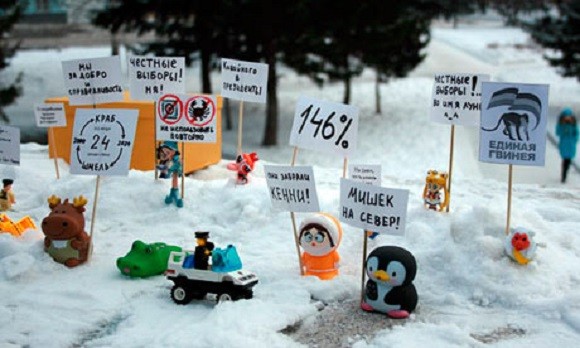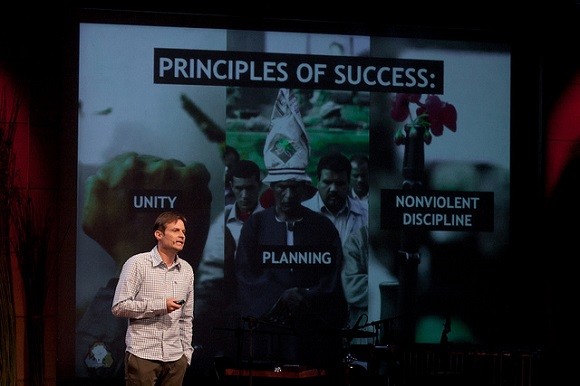 Protestors are getting creative with nonviolent tactics all over the world. This protest by Lego figurines and stuffed animals in Russia is an example of unconventional methods being used to achieve democratic change. Image credit: Bruce n h
Protestors are getting creative with nonviolent tactics all over the world. This protest by Lego figurines and stuffed animals in Russia is an example of unconventional methods being used to achieve democratic change. Image credit: Bruce n hTea, toys and teddy bears: it’s not how people imagine revolutions, but these are the techniques that have proved effective in social movements worldwide. In his new book Blueprint for Revolution: How to Use Rice Pudding, Lego Men, and Other Nonviolent Techniques to Galvanize Communities, Overthrow Dictators, or Simply Change the World, Srdja Popovic illustrates why creative and peaceful tactics can work better than bullets and bombs to bring about social and political change.
The book is filled to the brim with real-life stories of how nonviolent techniques are working all over the world, interweaved with Popovic’s own experiences as a leading member of Serbia’s Otpor! movement: in the 1990s, he played a leading role in transforming a small protest group of disgruntled young Serbians into a popular mass movement, bringing an end to the thirteen year rule of dictator Slobodan Milosevic. As co-founder of the organisation CANVAS (The Centre for Applied Nonviolent Action and Strategies), Popovic now uses his own experiences in nonviolent struggle to train activists seeking democratic change all over the world.
Frodo Baggins: a modern day revolutionary
Peace Direct recently attended London's Frontline Club to hear Popovic discuss Blueprint for Revolution. He joined Amnesty International’s Steve Crawshaw in discussion, describing why and how nonviolence works.
Can nonviolence really be effective against powerful dictators? It might be difficult to believe, but Popovic puts it simply in his book: "If you’re up against David Beckham, you don’t want to meet him on the soccer field. You want to play him at chess." In the same way, taking up arms against an army-backed dictator is foolish. But peaceful revolution can involve people of all ages and sizes, rather than requiring skilled fighters. And as Popovic explained, the more people behind a movement the better.
Revolutions and video games: building from small victories
This doesn't mean to say that nonviolent revolution is simple or easy. Talking to Crawshaw, Popovic said that "there are in the end only two types of non-violent revolution; the spontaneous and the successful. You can't have both".
Planning is key to the success of a non-violent movement, and it was a well-thought out strategy that enabled Otpor! to turn from a small protest group into a movement of 70,000, all without the use of violence. Moving away from Lord of the Rings and onto video games, Popovic explained how a social movement consists of a series of levels which get harder as the movement continues.
But much like a frustrated gamer, activists often only pay attention to the 'game over', rather than the small victories. Popovic aims to persuade protesters to be more like Gandhi; campaigning in small steps which lead to a mass movement. This is what a good strategy looks like - 'building from small victories'.
 According to Popovic, unity, planning and a commitment to nonviolent discipline are the three core principles of success when it comes to nonviolent revolution. Image credit: Bartolomeo Koczenasz
According to Popovic, unity, planning and a commitment to nonviolent discipline are the three core principles of success when it comes to nonviolent revolution. Image credit: Bartolomeo KoczenaszLaughtivism: the power of humour in nonviolent struggle
Speaking to Peace Direct on the power of laughtivism, Popovic said that "humour has three important effects in nonviolent struggle: breaking fear and apathy, making your movements 'cool and in', and most importantly harming your opponent. Rulers in power just tend to be clumsy when mocked - and often do something stupid in response to "laughtivism" - making themselves vulnerable for further mocking".
As he says, humour works, for three main reasons:
- Humour is a fear breaker. It has a physiological element: when somebody cracks a joke, fear disappears.
- Humour has a cool factor. Funniness is attractive. Just as a sense of humour in other people often attracts us, activism which incites laughter makes people want to join a movement. Humour makes activism cool.
- Humour is a teaser to the opponent. People in power tend to take themselves too seriously. If you start mocking them with jokes and parodies, they get angry and react in silly ways, making themselves look ridiculous along the way.







